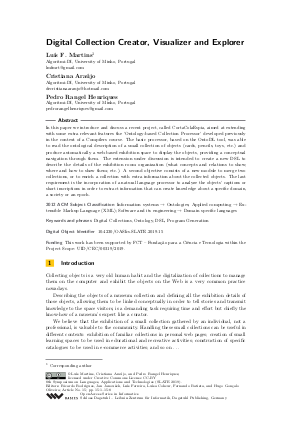Digital Collection Creator, Visualizer and Explorer
Authors Luís F. Martins, Cristiana Araújo, Pedro Rangel Henriques
-
Part of:
Volume:
8th Symposium on Languages, Applications and Technologies (SLATE 2019)
Part of: Series: Open Access Series in Informatics (OASIcs)
Part of: Conference: Symposium on Languages, Applications and Technologies (SLATE) - License:
 Creative Commons Attribution 3.0 Unported license
Creative Commons Attribution 3.0 Unported license
- Publication Date: 2019-07-24
File

PDF
OASIcs.SLATE.2019.15.pdf
- Filesize: 0.69 MB
- 8 pages
Document Identifiers
Subject Classification
ACM Subject Classification
- Information systems → Ontologies
- Applied computing → Extensible Markup Language (XML)
- Software and its engineering → Domain specific languages
Keywords
- Digital Collections
- Ontology
- DSL
- Program Generation
Metrics
- Access Statistics
-
Total Accesses (updated on a weekly basis)
0PDF Downloads0Metadata Views
Abstract
In this paper we introduce and discuss a recent project, called CortaColaEspia, aimed at extending with some extra relevant features the 'Ontology-based Collection Processor' developed previously in the context of a Compilers course. The basic processor, based on the OntoDL tool, was able to read the ontological description of a small collection of objects (cards, pencils, toys, etc.) and produce automatically a web-based exhibition space to display the objects, providing a conceptual navigation through them. The extension under discussion is intended to create a new DSL to describe the details of the exhibition room organization (what concepts and relations to show; where and how to show them; etc.). A second objective consists of a new module to merge two collections, or to enrich a collection with extra information about the collected objects. The last requirement is the incorporation of a natural language processor to analyze the objects' captions or short inscriptions in order to extract information that can create knowledge about a specific domain, a society or an epoch.
Cite As Get BibTex
Luís F. Martins, Cristiana Araújo, and Pedro Rangel Henriques. Digital Collection Creator, Visualizer and Explorer. In 8th Symposium on Languages, Applications and Technologies (SLATE 2019). Open Access Series in Informatics (OASIcs), Volume 74, pp. 15:1-15:8, Schloss Dagstuhl – Leibniz-Zentrum für Informatik (2019)
https://doi.org/10.4230/OASIcs.SLATE.2019.15
BibTex
@InProceedings{martins_et_al:OASIcs.SLATE.2019.15,
author = {Martins, Lu{\'\i}s F. and Ara\'{u}jo, Cristiana and Henriques, Pedro Rangel},
title = {{Digital Collection Creator, Visualizer and Explorer}},
booktitle = {8th Symposium on Languages, Applications and Technologies (SLATE 2019)},
pages = {15:1--15:8},
series = {Open Access Series in Informatics (OASIcs)},
ISBN = {978-3-95977-114-6},
ISSN = {2190-6807},
year = {2019},
volume = {74},
editor = {Rodrigues, Ricardo and Janou\v{s}ek, Jan and Ferreira, Lu{\'\i}s and Coheur, Lu{\'\i}sa and Batista, Fernando and Gon\c{c}alo Oliveira, Hugo},
publisher = {Schloss Dagstuhl -- Leibniz-Zentrum f{\"u}r Informatik},
address = {Dagstuhl, Germany},
URL = {https://drops.dagstuhl.de/entities/document/10.4230/OASIcs.SLATE.2019.15},
URN = {urn:nbn:de:0030-drops-108829},
doi = {10.4230/OASIcs.SLATE.2019.15},
annote = {Keywords: Digital Collections, Ontology, DSL, Program Generation}
}
Author Details
Funding
This work has been supported by FCT – Fundação para a Ciência e Tecnologia within the Project Scope: UID/CEC/00319/2019.
References
-
Ines Ceh, Matej Crepinsek, Tomaz Kosar, and Marjan Mernik. Ontology driven development of domain-specific languages. Comput. Sci. Inf. Syst., 8(2):317-342, 2011.

-
Thomas R. Gruber. Toward principles for the design of ontologies used for knowledge sharing. In International Journal of Human-Computer Studies, pages 907-928. Kluwer Academic Publishers, 1993.

- Milan Kosanović, Igor Dejanovic, and Gordana Milosavljevic. Applang – A domain-specific language for rapid development of data-oriented mobile applications. In Int. Conf. of Numerical Analysis and Applied Mathematics, ICNAAM, volume 1738, page 240003, June 2016. URL: https://doi.org/10.1063/1.4952022.
- Tomaž Kosar, Sudev Bohra, and Marjan Mernik. Domain-Specific Languages: A Systematic Mapping Study. Information and Software Technology, pages -, 2015. Accepted manuscript (article in Press). URL: https://doi.org/10.1016/j.infsof.2015.11.001.
- Ricardo G. Martini, Cristiana Araújo, Pedro Rangel Henriques, and M.João Varanda Pereira. CaVa: an example of the automatic Generation of Virtual Learning Spaces. In Álvaro Rocha, Hojjat Adeli, Luís Paulo Reis, and Sandra Costanzo, editors, Trends and Advances in Information Systems and Technologies, WorldCist2018, volume 745 of Advances in Intelligent Systems and Computing, pages 633-643. Springer International Publishing, Cham, March 2018. URL: https://doi.org/10.1007/978-3-319-77703-0_63.
-
Ricardo Giuliani Martini. Formal Description and Automatic Generation of Learning Spaces based on Ontologies. PhD thesis, University of Minho, September 2018.

- Marjan Mernik, Jan Heering, and Anthony M. Sloane. When and how to develop domain-specific languages. ACM Comput. Surv., 37(4):316-344, December 2005. URL: https://doi.org/10.1145/1118890.1118892.
- Terence Parr. ANTLR. http://www.antlr.org/, 2016. Accessed: 2016-09-14.
-
Agnis Stibe and Janis Bicevskis. Web Site Modeling and Prototyping Based on a Domain-Specific Language. In Computer Science and Information Technologies Vol. 751, pages 7-21, Riga, Latvia, 2009. Scientific Paper, University of Latvia.

